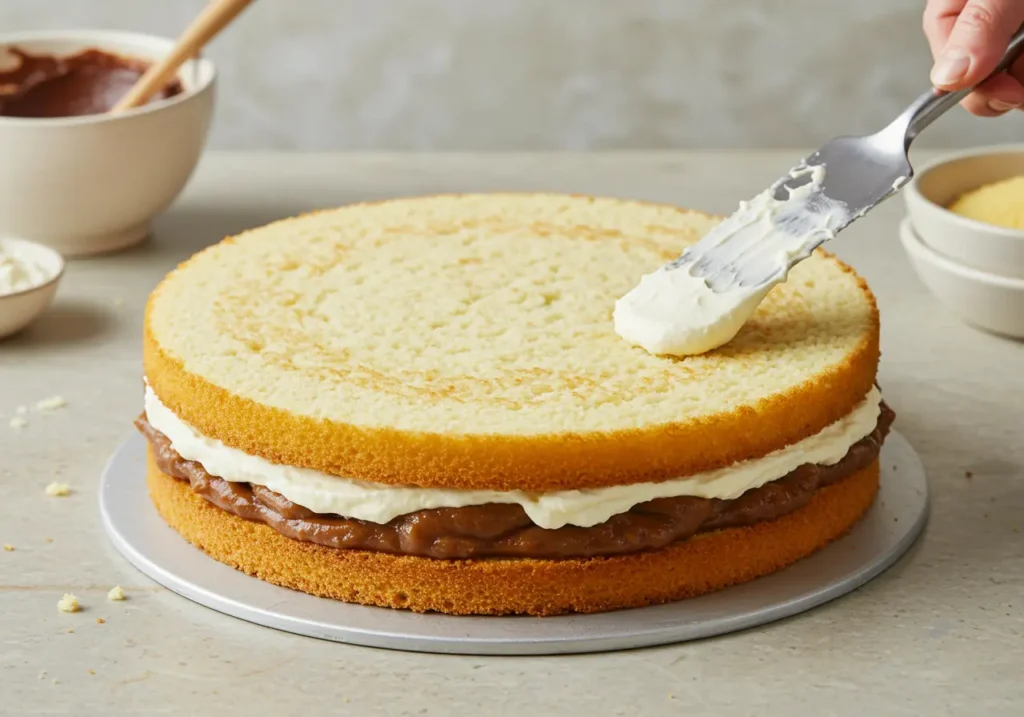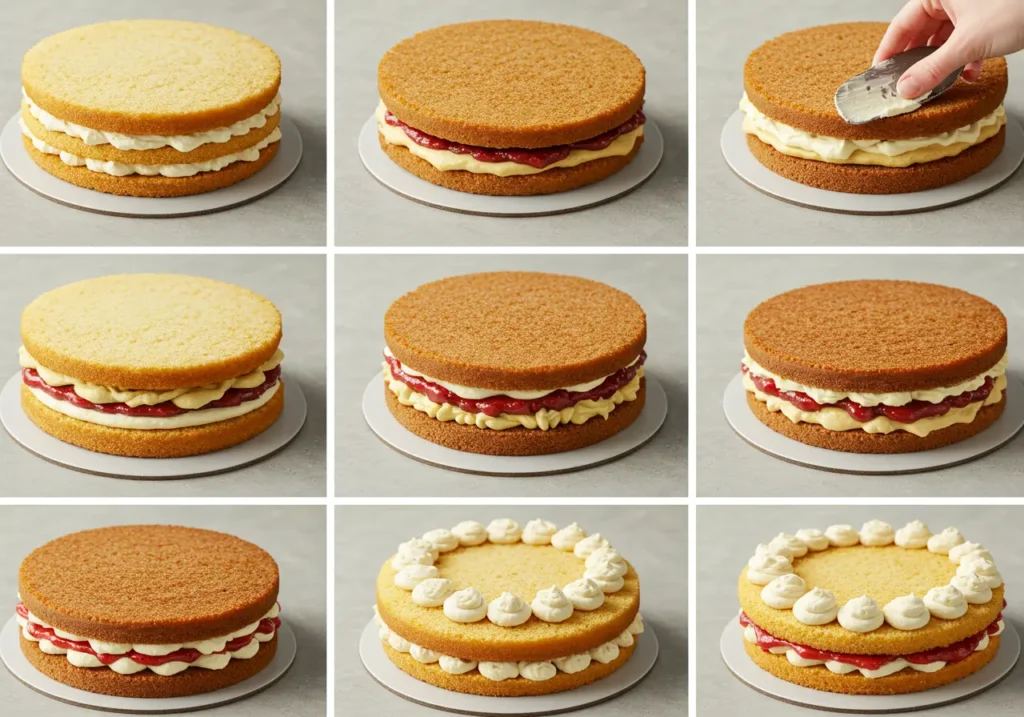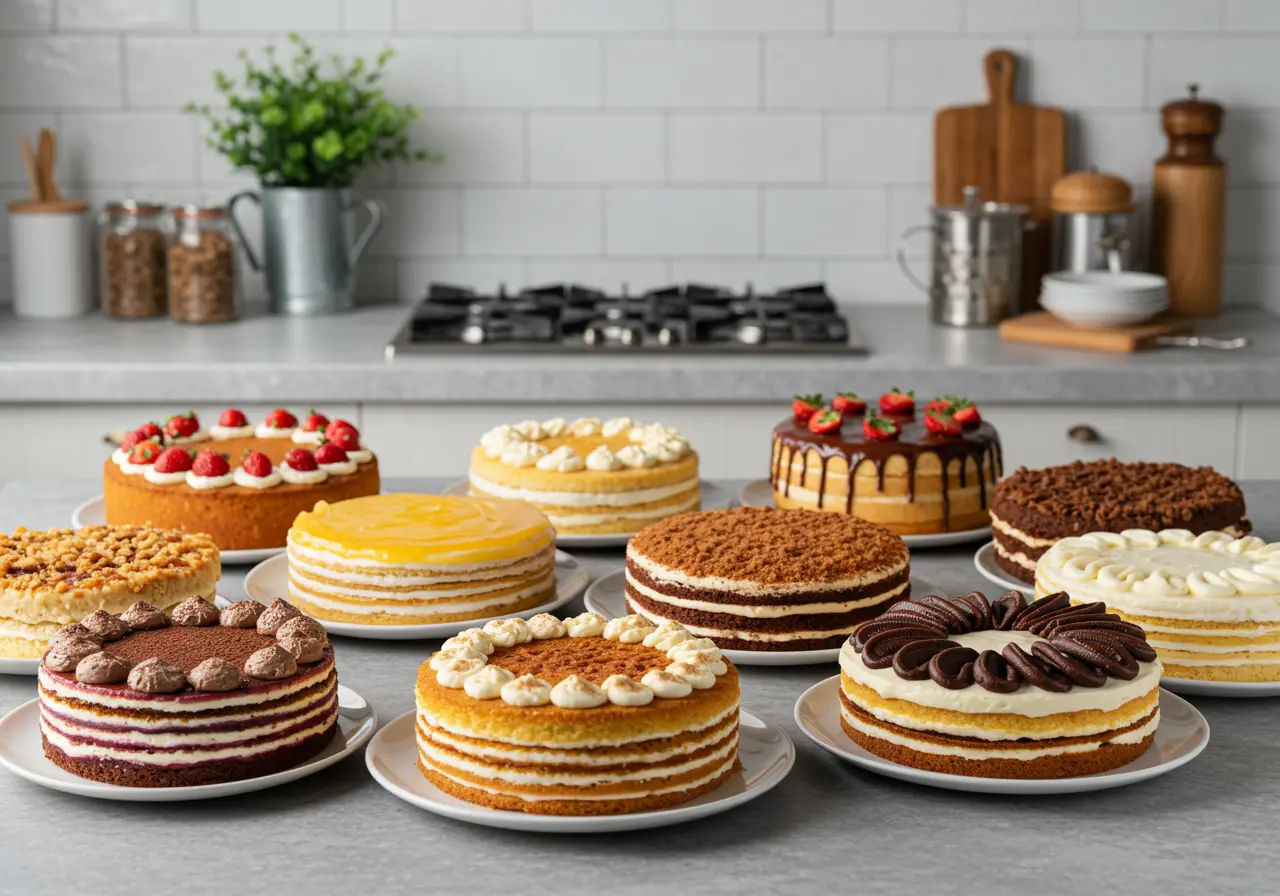Want to explore impressive desserts? This article dives into what are other layered cake recipes. Discover exciting ideas and techniques to create stunning multi-tiered cakes.
Introduction to Layered Cake Recipes
Layered cakes are a showstopper at any event. However, they can seem complex to make. This article will explore what are other layered cake recipes besides the typical ones. We will cover various flavors, techniques, and designs. Therefore, you’ll gain the skills to make your own beautiful creations.
Why Choose Layered Cakes?
Layered cakes are not just visually appealing. Also, they offer a great taste experience. Indeed, the combination of cake, filling, and frosting provides many flavor options. Moreover, the layers can enhance both texture and taste. Consequently, layered cakes are a great choice for celebrations and special occasions.
The Art of Layering
The key to a great layered cake is proper layering. This involves baking even layers and using the right fillings. Additionally, it requires a steady hand when stacking. Furthermore, the final frosting should be smooth and even. Therefore, mastering layering is essential for success.
Exploring Different Types of Layered Cakes
What are other layered cake recipes can range widely in flavor and design. Let’s explore some popular options that go beyond the basics.
Classic Layered Cake Varieties
- Chocolate Layer Cake: A timeless favorite that’s rich and decadent. It often includes chocolate buttercream frosting.
- Vanilla Layer Cake: This cake is light, versatile, and it pairs well with many fillings. You can use a variety of frostings.
- Carrot Layer Cake: A moist cake with spices, it often features cream cheese frosting. Also, it can include nuts and raisins.
Key Characteristics of Classic Layered Cakes
Classic layered cakes often have simple but delicious flavors. They use straightforward techniques and familiar ingredients. Therefore, they are a great place to start your layered cake journey.
Unique Flavor Combinations for Layered Cakes
- Lemon Raspberry Layer Cake: A tangy and sweet combination that’s refreshing and light. The lemon and raspberry are a great pairing.
- Salted Caramel Layer Cake: A balance of sweet and salty, this cake is both indulgent and flavorful. The caramel adds a delicious depth.
- Coconut Cream Layer Cake: A tropical flavor with a rich coconut flavor and creamy texture. This is a great alternative for something different.
Finding Creative Flavor Pairings
Experimenting with flavor combinations can make your cakes stand out. Think about how different flavors interact. Also, consider textures to create something unique. Furthermore, balance sweet and tart flavors for best results.
Techniques for Baking Perfect Layers

Proper techniques are key to baking perfect cake layers. What are other layered cake recipes all benefit from a solid foundation. Here are some essential baking tips.
Ensuring Even Baking
Use a kitchen scale to measure your ingredients. Additionally, make sure your oven is at the correct temperature. Moreover, using baking strips can help the cake bake evenly. Indeed, even baking is critical.
Preventing Dome-Shaped Cakes
Avoid over-mixing your batter. Additionally, use baking strips around your cake pans. This can prevent the cake from doming. Furthermore, use the right amount of batter in your pans. Therefore, you should get flat layers.
Achieving Level Cake Layers
Once baked, allow your cake to cool. Then, use a serrated knife to carefully level the tops. Also, a cake leveler is a useful tool for this. This helps to achieve even layers when stacking.
Cutting Cakes Into Equal Layers
To get even layers, slice your cakes horizontally. Furthermore, you can use a cake leveler for this. This ensures that each layer is the same thickness and look.
Layering and Assembling Your Cake
Assembling your cake correctly is important. What are other layered cake recipes all require proper assembly to ensure structure and beauty.
Choosing the Right Fillings
Select fillings that complement the cake. Consider flavor and texture. Also, make sure the filling isn’t too runny. This will prevent the cake from sliding.
How to Apply Fillings Evenly
Use an offset spatula to spread the filling evenly over each layer. Furthermore, don’t apply too much or too little. This way each layer of the cake will be balanced.
Stacking Cake Layers
Use a cake board or plate as your base. Place the first cake layer on the base. Then, carefully stack each layer with the filling. Also, use a level to make sure your cake is straight.
Creating a Stable Structure
Use dowels or straws if you need extra support. These are particularly useful for taller cakes. Moreover, chill your cake after stacking for better stability. Indeed, this is key for a sturdy cake.
Frosting and Decorating Layered Cakes
Frosting adds a finishing touch to your cake. What are other layered cake recipes are all finished with frosting for texture and flavor.
Choosing the Right Frosting
Select a frosting that compliments your cake. Furthermore, consider the flavors of the cake and the filling. Also, choose the appropriate texture.
Types of Frosting to Use
- Buttercream: This is a classic choice that is smooth and creamy. There are many flavor options with this choice.
- Cream Cheese Frosting: This tangy frosting is great with carrot cake and spice cakes. Also, it pairs well with many other flavors.
- Chocolate Ganache: This is a rich and decadent option. It works well with chocolate or vanilla cakes.
Creating a Smooth Frosting Finish
Use an offset spatula or a cake scraper. This helps to create a smooth, even frosting layer. Also, chill the cake before frosting. This makes the process easier and more smooth.
Adding Decorative Elements
Use piping tips, sprinkles, or fresh fruit to decorate. Also, chocolate shavings or edible flowers can add a professional touch. Therefore, decorating allows you to personalize the final design.
Adapting Layered Cake Recipes
Layered cake recipes can be altered to suit various needs. What are other layered cake recipes can be made gluten-free, dairy-free, and vegan.
Gluten-Free Layered Cake Options
Use gluten-free flour blends to make your cake. Also, add a binder like xanthan gum. Moreover, ensure all ingredients are gluten-free. This caters to those with gluten intolerance.
Substituting Gluten-Free Flours
Experiment with different gluten-free flour blends to find the texture you like. Also, consider using almond flour or rice flour. However, make sure to balance with a starch like tapioca or corn.
Dairy-Free Layered Cake Alternatives
Use dairy-free alternatives like coconut oil or avocado oil. Additionally, substitute milk with almond or soy milk. Also, use non-dairy buttercream or ganache. These are easy swaps with great results.
Using Plant-Based Substitutes
Use plant-based butter, plant-based milk, and flax eggs. These are great for dairy free and vegan cakes. Indeed, they offer great alternatives to traditional dairy ingredients.
Vegan Layered Cake Creations
Use plant-based butter, milk, and flax eggs. Additionally, ensure your fillings and frostings are vegan as well. These are all required for a fully vegan layered cake.
Creating Vegan Frostings and Fillings
Use coconut cream, plant-based butter, or nut butter. Also, vegan chocolate is a great choice for ganache. These vegan options offer great taste and texture.
Exploring Unique Fillings for Layered Cakes
What are other layered cake recipes often feature exciting fillings that go beyond the basic buttercream. Therefore, let’s delve into some unique filling ideas. These can elevate the overall flavor and texture of your layered cake creations.
Fruit-Based Fillings
- Berry Compotes: Fresh or frozen berries cooked down into a thick, flavorful compote add both sweetness and tartness. These can be used with or without added sugar.
- Citrus Curds: Lemon, lime, or orange curd offers a tangy burst of flavor. This works particularly well with sweeter cakes.
- Stone Fruit Purees: Peach, apricot, or plum purees provide a smooth, rich texture. They are a great choice for cakes with milder flavors.
- Tropical Fruit Fillings: Mango, passion fruit, or pineapple fillings add a tropical twist. They also provide a refreshing burst of flavor.
Cream and Mousse Fillings
- Mascarpone Cream: This creamy, rich filling is smooth and silky. It pairs well with fruit and chocolate cakes.
- Chocolate Mousse: This light and airy filling provides a decadent touch. Moreover, it complements chocolate cakes or vanilla cakes.
- Coffee or Tea Infused Mousses: Mousse infused with coffee or tea adds a subtle, sophisticated touch. Furthermore, it is a great way to create a unique flavor.
- Caramel Mousse: A smooth, creamy caramel mousse offers a sweet and indulgent filling. It is perfect for pairing with spiced or chocolate cakes.
Nut-Based Fillings
- Praline Paste: A sweet, nutty paste adds a crunchy element and a rich flavor. This pairs well with chocolate and caramel flavors.
- Almond Cream: This offers a smooth, nutty flavor that complements fruit or spice cakes. Also, it provides a smooth and even texture.
- Hazelnut Spread: Similar to Nutella, this provides a creamy, indulgent, nutty option. Moreover, it can be used alone or combined with other fillings.
Innovative Frosting Techniques for Layered Cakes

Frosting is more than just a topping. It can be a work of art. Let’s explore some innovative frosting techniques for what are other layered cake recipes.
Mirror Glaze
- This provides a smooth, glossy, reflective finish. It is visually striking and very elegant. Moreover, the mirror glaze is a good choice for a special occasion.
- Tips: Work with a smooth base layer. Also, make sure the glaze is at the right temperature for a smooth coat. Additionally, let it set before serving.
Ombre Frosting
- This technique uses a gradient of colors from light to dark. It can be achieved by gradually adding food coloring. Furthermore, this gives a visually appealing result.
- Tips: Start with a light shade, then gradually add more color to the frosting. Use an offset spatula to blend the colors for a seamless transition. Also, choose complementary colors for the best effect.
Textured Frosting
- This uses a variety of tools and techniques to create texture on the frosting. Some options include swirls, peaks, and ridges. Also, this method adds visual appeal.
- Tips: Use different piping tips to create a variety of textures. Also, use a spatula or spoon to make different patterns. Experiment with your preferred tools to get the right look.
Drip Cakes
- This style is indulgent and fun, featuring chocolate or caramel drips down the sides of the cake. It offers a beautiful and delicious look.
- Tips: Use a ganache or melted candy melts for the drips. Also, let the drips set before adding any additional decorations. Furthermore, do not make them too thick, or they won’t look right.
Adding Decorative Elements to Layered Cakes
What are other layered cake recipes are enhanced by their decorations. Let’s explore ways to add visual appeal to your cakes.
Fresh Flowers
- Edible flowers add a natural and elegant touch. Furthermore, they enhance the look.
- Tips: Ensure the flowers are edible and food safe. Wash them thoroughly before using. Also, use flowers that complement the cake’s color.
Chocolate Decorations
- Use chocolate curls, shavings, or shards for an elegant finish. Also, custom-shaped chocolates can add to the look.
- Tips: Use a vegetable peeler to make chocolate shavings. Melt chocolate and use a mold to make custom designs. Choose dark, milk, or white chocolate as your base.
Fruit Arrangements
- Fresh berries, slices of citrus, or other fruits provide a colorful touch. Also, use them to complement the cake’s filling.
- Tips: Arrange the fruit attractively. Also, consider the colors and sizes of your chosen fruits. Use fruit that is in season.
Sprinkles and Edible Glitter
- These are an easy way to add a fun, festive touch. They are great for celebrations.
- Tips: Choose sprinkles that complement the cake’s color. Also, use edible glitter sparingly. These can enhance any cake design.
Advanced Techniques for Layered Cakes
For those ready to take their skills to the next level, here are some advanced techniques. What are other layered cake recipes can sometimes benefit from more complex methods.
Working with Fondant
- Fondant provides a smooth, even surface for detailed decorations. However, it requires practice to work with.
- Tips: Knead the fondant well before using. Also, use a smooth base. Dust your surface with powdered sugar. Practice shaping and molding the fondant.
Creating Sugar Flowers
- These handmade decorations require time and skill. However, they provide a beautiful look.
- Tips: Use gum paste to make sugar flowers. Also, use food coloring to create custom colors. Allow the flowers to dry completely before using.
Airbrushing
- Airbrushing offers gradients and ombre effects. Also, it can provide a smooth, even color base.
- Tips: Practice your technique on parchment paper first. Also, use food-safe airbrush colors. Be sure to clean your airbrush equipment properly.
Frequently Asked Questions (FAQs)
Here are some common questions about making layered cakes. These will provide some help. What are other layered cake recipes are easier to make when you have these answers.
What are multi layered cakes called?
Multi-layered cakes are often called tiered cakes. Also, they can be referred to as layer cakes or celebration cakes. The specific term often depends on the complexity of the cake. Moreover, it can depend on its design.
What type of cake is best for layers?
Dense cakes, such as pound cake or genoise, are best for layers. They are sturdy enough to hold fillings and frosting. Moreover, these cakes maintain their structure well. Therefore, they’re ideal for layered cakes.
Which cake is best for layering?
Butter cakes and sponge cakes are great for layering. They are not too delicate. In addition, they absorb moisture well. Therefore, they complement fillings and frostings nicely.
What is the most layered cake?
The most layered cake is a crepe cake. Also, Mille-feuille, a French pastry, is another very layered cake. These options showcase lots of thin layers. However, they tend to have a different style than other layered cakes.

